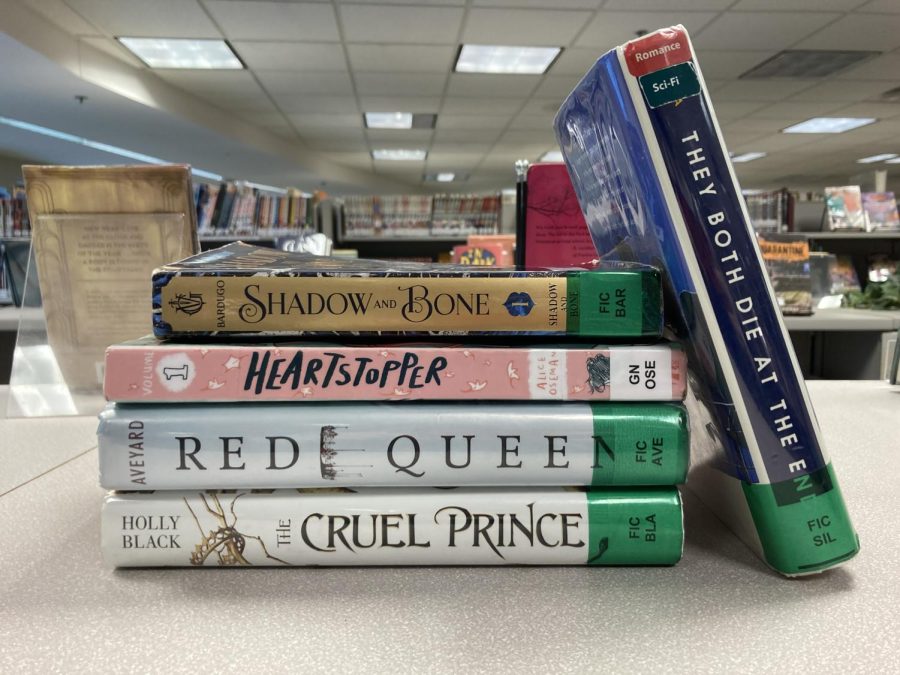‘BookTok’ takes over the reading world
TikTok hashtag changes publishing
BookTok books in the Park library. Each of these books has found fame on the social media platform TikTok over quarantine.
March 2, 2022
If you’ve been on TikTok at all recently, I’m sure you’ve heard of BookTok.
The hashtag recently hit 39 billion views on the platform and its impact on the young adult genre has been astronomical.
Books that went under the radar upon first release are shooting to the top of the New York Times Best Sellers List, and authors that were underappreciated in the past are finally earning their flowers.
Books like “They Both Die at the End” by Adam Silvera, “The Song of Achilles” by Madeline Miller and “Shadow and Bone” by Leah Bardugo have seen surges in popularity to the point where some have already been adapted for television.
“Shadow and Bone” was released as a Netflix Original to an avalanche of positive reviews through the movement, and “My Year of Rest and Relaxation” by Ottessa Moshfegh is set to be released as a movie starring Emma Stone. “It Ends With Us,” a novel by Colleen Hoover, hit the NYT Best Seller List in 2020, four years after its initial release. Also in 2020 — Barnes and Noble, the largest bookstore chain in the United States, opened up a “booktok” section on their website.
In 2022, it’s safe to say the impact of #booktok has been firmly planted, for better or for worse. On one side, #booktok is responsible for getting millions of teens, mostly young women, into reading. Most of the books praised on the site are well written, interesting and impactful. I remember reading “My Year of Rest and Relaxation” after I saw a TikTok about it, and I loved that book.
#Booktok also supports the classics, praising the works of Jane Austen, Louisa May Alcott and Oscar Wilde. I read “the Bell Jar” because of a recommendation from the site, and it started my love for Sylvia Plath.
Tiktok is responsible for spotlighting a lot of queer books as well. Two of the most popular, “They Both Die at the End” and “Song of Achilles,” follow LGBTQ+ relationships. However, most of the queer books on BookTok center MLM [man loving man] relationships, with only a couple of the most prevalent having anything sapphic.
Booktok also has a history of making books of questionable quality popular. “Red White and Royal Blue” by Casey Mcquiston, released in 2019, was swept up in the wave of Booktok’s “must read” recommendations in 2020, but the book is not very good. It idolizes certain politicians and political stances and handles its subject matter lazily.
Even “They Both Die at the End,” one of the most popular books on the site, was featured in a TikTok with almost a million likes touting it as “the worst book on #booktok.”
Another problem with the hashtag is its inclusivity, specifically with race. Most, if not all, of the most popular books center white protagonists, which can be discouraging for POC teens who want to read books with characters who look like them. #Booktok also supports a transactional relationship with reading, with creators showing off hundred-dollar Barnes and Noble hauls of the newest books, with only the best covers. This creator is an example. Her caption reads: “buying books> reading books.”
Going to the library is something I’ve never heard even discussed under the hashtag. Due to #booktok, public libraries have been treated like such an afterthought compared to buying books. This leads to the overconsumption of books, some of which people will never read.
As a reader, I’m conflicted on the impact of #booktok. It’s rekindled so many people’s love for reading, but it also commodifies it in a way that makes it less accessible.




